by W.R. Jacobi and W.S. Cranshaw * (12/14)
Quick Facts…
- Pinyon pines are well-suited to many parts of Colorado.
- These pines make good visual screens, windbreaks, and wildlife habitat.
- Major diseases include black stain root disease, dwarf mistletoe, armillaria root disease, and pinyon decline.
- Common insect pests are pinyon pitch mass borer, Ips beetles, pinyon tip moth, pinyon pitch nodule moth, pinyon needle scale, and pinyon spindlegall midge.
- To ensure optimum health, avoid wounding trees, choose an appropriate site, water properly, and give trees adequate space.
Pinyon pines are hardy, drought-tolerant trees well-suited to many Colorado landscapes. Their dense growth habit provides good visual screening and wind protection, and they offer shelter and food for birds and other wildlife. Site selection and proper maintenance are important for tree health.
Major Diseases
Black Stain Root Disease (Leptographium wagneri)
This vascular disease causes extensive black staining of the sapwood in the root and lower stem before killing the sapwood. Bark beetles tend to follow as secondary pathogens and eventually cause the death of the tree. Spread occurs through root grafts and root contacts, and by insects that carry the spores (reproductive structures of the disease). Affected trees usually are in a group.
Dwarf Mistletoe (Arceuthobium divaricatum)
These are small, leafless, parasitic flowering plants that grow on branches and spread only to other pinyon pines. They kill slowly by robbing the tree of its nutrients and water. Reproduction occurs when sticky seeds explosively discharge from the plant and adhere to the branches and needles of their next host. The life cycle from germination to dissemination is six years. This relatively slow rate of spread allows time for appropriate action.
Armillaria Root Disease (Armillaria spp.)
Armillaria spreads along roots and by rhizomorphs (fungal-root-like structures). One tree or a group can be attacked. The fungus can subsist on dead, woody material for more than 35 years. Armillaria prefers to infect trees that are already stressed by environmental factors or other pathogens. It prefers moist sites, moderate temperatures and is rarely found on extremely hot, cold or dry sites.
Pinyon Decline
Trees stricken with pinyon pine decline die slowly over several years. Affected trees have distinct symptoms that separate this disease from other problems commonly seen on pinyons. This environmental-related disease is not related to bark beetles, black stain root disease or other common problems. Environmental stresses such as winter drought followed by a hot summer may trigger the decline.
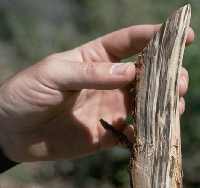 |
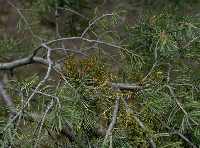 |
| Figure 1: Vertical staining from black stain root disease. | Figure 2: Dwarf mistletoe broom and plants. |
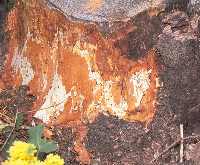 |
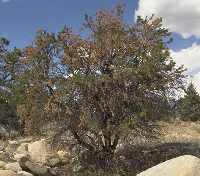 |
| Figure 3: White fungal fans of Armillaria spp. | Figure 4: Erratic branch mortality of pinyon decline. |
| Table 1: Diseases of pinyon pines. | |
| Signs and Symptoms | Management Options |
|---|---|
| Black Stain Root Disease | |
|
|
| Dwarf Mistletoe | |
|
|
| Armillaria Root Disease | |
|
|
| Pinyon Decline | |
|
|
Major Insects
Pinyon “Pitch Mass” Borer (Dioryctria ponderosae)
The larvae of this insect are pale yellow or pink with a light brown head. Larvae live underneath a pitch mass. Adult moths are active and lay eggs in tree wounds from late June through August. The larvae undergo four molts before changing to the pupal stage. Pupation takes place in the chamber of pitch and silk produced by the larvae. Larval feeding over the summer causes most of the damage. The life cycle is complete in one, sometimes, two years.
Ips (Engraver) Beetles (Ips spp.)
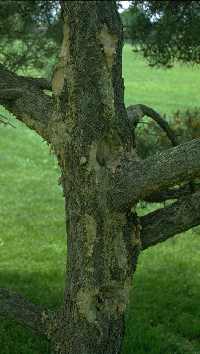 |
| Figure 5: Pitch mass borer damage. |
Adults are 1/8 to 1/4 inch long and reddish-brown to black. They have a pronounced cavity on the rear end that is lined with three to six pairs of tooth-like spines. Larvae are small, legless grubs (1/4 inch) that are white to dirty gray with dark heads. Adults lay eggs along galleries. Once the larvae hatch, they feed just inside the bark and mine away from the pupal chamber. From egg to adult takes 21 to 40 days in summer and several months in winter. The beetles are dormant during the coldest months, but sometimes are seen to be flying in early November and late February. Two to three generations are produced in most years with increased number of generations during warmer years.
Pinyon Tip Moth (PTM) (Dioryctria albovittella)
Pinyon Pitch Nodule Moth (PPNM) (Retinia arizonensis)
PTM: Adults are small grayish moths. Larvae are light golden brown with a dark brown head capsule up to 3/4 inches long. They overwinter in a small, silk cocoon on the bark. In mid- to late May, they feed by tunneling into the base of the unopened buds. They mine the pith of the terminal growth, causing more damage as they grow. Large larvae move on to new tissue, cones or shoots. Pupation occurs inside the terminals and cones. Adults lay eggs from late June through August. There is one generation per year.
PPNM: Adults are a rusty brown. The larvae are reddish-yellow caterpillars with a black head and dark area behind the head. They overwinter as partially grown larvae within pitch nodules. Feeding resumes in spring and pupation follows in late spring. Adult flights typically peak in late July and early August. Eggs are laid on needle sheaths and the newly hatched larvae feed on young needles, later tunneling into shoots. There is one generation per year.
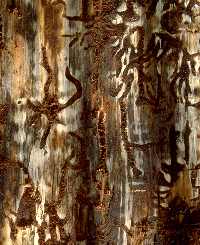 |
| Figure 6: Ips galleries on pinyon. |
Pinyon Needle Scale
(Matsucoccus acalyptus)
Females overwinter on the needle as a legless nymph that resembles a small black bean. Development into the mobile adult form resumes in the spring. Mating occurs in early April. Eggs are laid in masses around the collar, branch crotches and underside of larger branches. The eggs are covered by a white, cottony wax. Newly hatched nymphs settle on the previous year’s needles. Second stage nymphs form in late summer and overwinter on the needles. There is one generation per year.
Pinyon Spindlegall Midge (Pinyonia edulicola)
Adults are tiny flies, about 1/16 inch long, with an orange abdomen. The larvae are small, legless orange maggots found within swellings that form at the base of needles. Six to 15 larvae occupy each gall, that form as a result of larval feeding. In preparation to pupate the larvae produce a silken, white covering within the gall a few weeks before adults emerge. Adults are present shortly after new growth is produced on pinyon and emergence is indicated by the pupal cases that extrude from the tips of the needles. Adults mate and lay eggs on terminal buds from mid-June until early July. The eggs hatch and the larvae migrate down to newly formed needles. There is one generation per year.
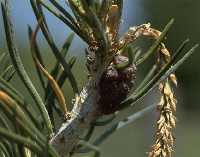 |
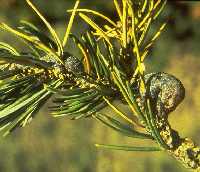 |
| Figure 7: Pinyon tip moth. | Figure 8: Pinyon pitch nodule moth. |
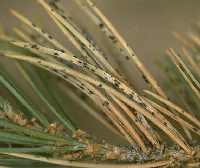 |
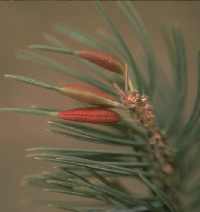 |
| Figure 9: Pinyon needle scale. | Figure 10: Spindlegall midge. |
| Table 2: Insects of pinyon pines. | |
| Signs and Symptoms | Management Options |
|---|---|
| Pinyon “pitch mass” borer | |
|
|
| Ips (Engraver) Beetles | |
|
|
| Pinyon Tip Moth (PTM)Pinyon Pitch Nodule Moth (PPNM) | |
|
|
| Pinyon Needle Scale | |
|
|
| Pinyon Spindlegall Midge | |
|
|
Proper Maintenance
Pinyon pines are a hardy species, but it is still important to minimize stress and wounding. They are drought-tolerant and do not grow well above 7,500 feet. To reduce stress, provide adequate space, avoid overwatering, and do not plant them in soils high in clay. Activities that can cause wounding are construction, planting, yard work and logging.
If you are building on a site with established pinyons, do not locate structures within two tree heights of the tree. This is the extent of the underground root system. Proper planting of new or transplanted pinyons can minimize problems in the short and long term. Use lawnmowers and weed trimmers carefully to avoid trunk damage. Log carefully to avoid basal scarring and accidental branch removal.
In general, closely planted and overcrowded pinyons are more susceptible to insects and diseases than trees with adequate light and space. Excessive moisture in irrigated landscapes promotes succulent growth and branch cracking. These conditions provide good entry, egg laying and feeding sites for some insect species. Pruning can also create infestation sites. Allow enough time for wounds to close before adult insects are active.
Related Fact Sheets
- 2.925, Dwarf Mistletoe Management.
- 2.926, Healthy Roots and Healthy Trees.
- 2.932, Environmental Disorders of Woody Plants.
- 5.529, Pine Tip Moths.
- 5.558, Ips Beetles.
- 7.423,Trees and Shrubs for Mountain Areas.
- 7.420, Protecting Trees During Construction.
*W.R. Jacobi and W.S. Cranshaw, professors; bioagricultural sciences and pest management. 8/99. Revised 12/14.
Go to top of this page.





